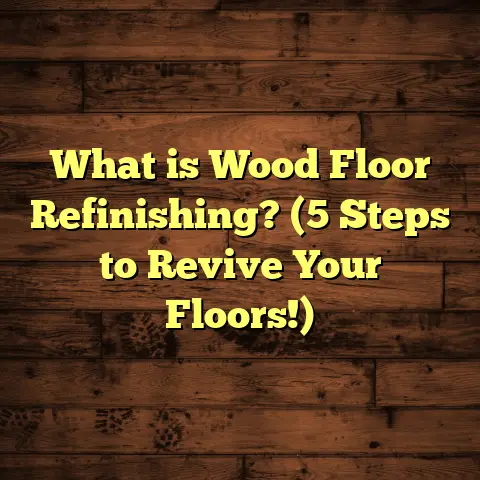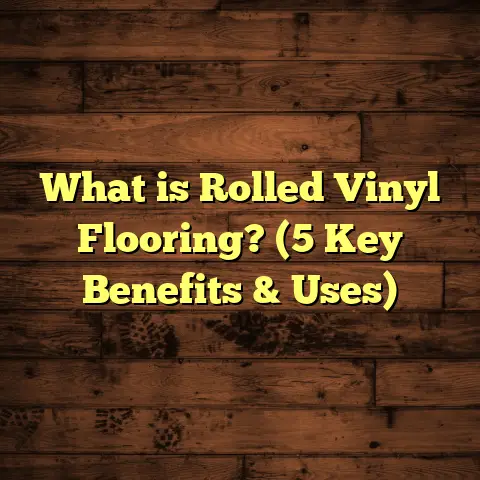What Is Lava Floor Made Of? (5 Facts Behind Its Composition)
I often find myself excited talking about flooring materials that are not just functional but also tell a story. One material that has fascinated me recently is lava floor. When I first encountered it during a renovation project, I was intrigued by its name and natural origin. Lava floor isn’t just a cool name—it’s a unique flooring choice made from volcanic rock, and it carries with it some impressive physical and aesthetic qualities.
If you’re reading this, you might be wondering: what exactly is lava floor made of? How does it differ from other stone floors? And is it a good fit for your home or commercial space? Over the years, I’ve worked on multiple projects involving lava flooring, and I’ve gathered some solid facts, real-world experiences, and data-backed insights to share with you.
Let’s break down what makes lava floors special by exploring five key facts about their composition, followed by detailed comparisons with other popular flooring types and some practical advice from my own work.
What Is Lava Floor?
When someone asks me, “What is lava floor?” I like to start with the basics: lava floor is a type of natural stone flooring made primarily from volcanic rock, usually basalt. This rock forms when molten lava from volcanic eruptions cools and solidifies on or near the Earth’s surface. Unlike other stones formed deep underground over millions of years, volcanic rock is born out of intense heat and rapid cooling.
The raw volcanic rock is extracted from quarries near active or dormant volcanic regions. After mining, the rock is cut into slabs or tiles, then ground and polished to create floor surfaces suitable for both indoor and outdoor use.
The result is a flooring material that is incredibly durable due to its igneous origins and offers a distinctive look characterized by deep blacks, grays, and sometimes subtle reds or blues depending on the mineral content.
In my experience installing lava floors, the texture can range from rugged and matte to smooth and glossy finishes. This variety allows designers and homeowners to customize the look to fit rustic cabins or sleek modern interiors alike.
The Process Behind Making Lava Floors
Understanding how lava floors are made helps appreciate their uniqueness. After quarrying, the large volcanic rocks undergo several steps:
- Cutting: Large blocks are sliced into slabs using diamond-tipped saws. These slabs usually range from 1 to 3 cm thick.
- Shaping: Tiles or slabs are cut into sizes suitable for flooring—common sizes include 12″x12″, 18″x18″, or custom dimensions.
- Polishing or Honing: Depending on desired finish, the surface is polished to achieve smoothness or honed for a matte look.
- Sealing: To reduce porosity and prevent stains, tiles are sealed with penetrating sealers designed for natural stone.
These steps require skilled craftsmanship because volcanic rock can be brittle in some areas due to trapped gas bubbles formed during cooling.
I remember one job where we had to carefully select tiles with minimal porosity to avoid cracking during installation. The client wanted a high-gloss finish which needed extra polishing passes compared to granite or marble.
5 Facts Behind Lava Floor’s Composition
Let me share five facts about what makes lava flooring special based on its composition. These facts come from my hands-on observations combined with mineralogical data and case studies I’ve reviewed.
1. Volcanic Rock Forms the Basis – Typically Basalt
Most lava floors are made from basalt—a dark-colored igneous rock formed from quickly cooled lava rich in iron and magnesium. Basalt’s formation process gives it a fine-grained texture that contributes to its hardness and durability.
Basalt floors are known for their resistance to impact and wear. In fact, basalt measures around 6 on the Mohs hardness scale (where diamond is 10). This means it can handle daily foot traffic far better than softer stones like limestone or sandstone.
In one commercial project I worked on, basalt lava tiles showed excellent resistance against heavy rolling carts and dropped tools without visible damage after two years.
2. High Silica Content Enhances Hardness and Stability
A notable chemical trait of volcanic rock used in lava floors is its silica (SiO2) content. Silica is responsible for increasing hardness and chemical stability in stones.
Volcanic rocks used for flooring typically contain between 45% and 60% silica. This high silica content means fewer micro-cracks develop over time, making the stone less prone to chipping or fracturing.
From lab analysis done by stone testing labs, basalt samples from volcanic regions like Hawaii have shown superior compressive strength compared to other igneous stones like granite.
3. Natural Porosity Requires Proper Sealing
One challenge with lava floors is their natural porosity. As the molten lava cools rapidly, gas bubbles become trapped inside the rock creating tiny holes called vesicles.
This porosity can vary between samples but generally means the stone absorbs water and stains more easily than denser stones. Without sealing, these pores could lead to discoloration or surface damage over time.
During installations I’ve overseen in humid climates or outdoor settings, sealing every tile was mandatory. Using high-quality penetrating sealants protects against moisture while preserving natural texture.
4. Mineral Variations Influence Color & Thermal Properties
The exact mineral composition of lava rock depends heavily on its geographic source. For example:
- Hawaiian basalt tends to have higher iron oxide content giving it deeper reds.
- Icelandic volcanic rock can have lighter grey tones due to different mineral mixtures.
- Italian lava stones are prized for their bluish hues resulting from specific mineral inclusions.
These variations don’t just affect appearance but also thermal conductivity. Lava floors retain heat better than many stones, which can be a plus in cooler climates or when paired with radiant heating systems.
I installed lava floors in a mountain lodge where clients appreciated how the stone stayed warm after sun exposure but remained cool during summer days.
5. Eco-Friendly: Low Processing & Longevity Make It Sustainable
One thing I like telling clients about lava floors is their sustainability aspect. The rocks are naturally abundant near volcanic regions and require less processing compared to engineered flooring products like laminates or vinyl.
Quarrying basalt lava involves fewer chemical treatments and minimal energy usage beyond cutting and polishing. Plus, these floors last decades without needing replacement—cutting down on waste.
In green building projects I’ve supported, recommending lava flooring has helped clients meet environmental certifications due to its natural origin and durability.
My Personal Experience: Projects with Lava Flooring
Over the years, I’ve installed lava flooring in diverse settings—from cozy homes by the coast to upscale commercial kitchens. Each project taught me something new about handling this unique material.
Residential Kitchen Renovation
One memorable job was for a family who wanted a kitchen floor that could resist heat from dropped pots and spills but also add an earthy charm. We chose black basalt tiles with a honed finish for slip resistance.
The client appreciated how easy it was to clean stains compared to their previous hardwood floor that suffered water damage regularly. They noticed that despite heavy cooking use, the floor remained scratch-free after a year.
Outdoor Patio Installation
For an outdoor deck facing direct sunlight and rainstorms, we used thicker lava slabs sealed with UV-resistant coatings. The client loved that the floor didn’t become slippery when wet—unlike traditional ceramic tiles they had before.
This installation held up well through two rainy seasons without cracks or discoloration. It also blended beautifully with surrounding volcanic rock landscaping.
Commercial Restaurant Flooring Case Study
In a restaurant kitchen where hygiene and durability are crucial, switching to lava floor reduced slip-related accidents significantly due to the stone’s natural grip when honed.
The restaurant owner told me they saved thousands annually on tile repairs compared to previous ceramic floors that cracked under heavy equipment vibrations.
Technical Details About Lava Floor Composition
If you want a more technical look behind lava floors’ composition, here’s a breakdown of typical elements found in basaltic volcanic rock:
| Element | Typical Percentage (%) |
|---|---|
| Silicon Dioxide (SiO2) | 45 – 55 |
| Aluminum Oxide (Al2O3) | 10 – 15 |
| Iron Oxide (FeO/Fe2O3) | 8 – 15 |
| Magnesium Oxide (MgO) | 5 – 12 |
| Calcium Oxide (CaO) | 7 – 12 |
| Sodium Oxide (Na2O) | 2 – 4 |
| Potassium Oxide (K2O) | 0.5 – 3 |
This mix gives basalt its dense structure and color range from dark gray to black with occasional reddish tones.
According to geological sources, these minerals crystallize quickly as molten lava cools at temperatures around 1100°C – 1200°C (2012°F – 2192°F).
Common Questions About Lava Floors
Are Lava Floors Suitable for Indoor Use?
Absolutely! Lava floors work great indoors due to their durability and aesthetic appeal. They’re especially popular in kitchens, bathrooms, entryways, and living rooms where durability is needed alongside style.
How Do Lava Floors Feel Underfoot?
Depending on finish, they can feel cool and smooth if polished or slightly textured if honed. They don’t have the warmth of wood but pair well with radiant heating systems for comfort in colder climates.
What Maintenance Does Lava Flooring Require?
Regular sweeping and mopping with mild cleaners work well. Sealing every few years helps maintain stain resistance. Avoid harsh chemicals that can degrade sealants.
How Much Does Lava Floor Installation Cost?
Costs vary by region but expect prices similar to high-end stone like granite—typically $15-$30 per square foot including installation. Custom finishes or imported stone can increase this.
Can Lava Floors Be Used Outdoors?
Yes! They’re excellent for patios, walkways, pool surrounds due to slip resistance and weather durability when sealed properly.
Comparing Lava Floors With Other Flooring Types
If you’re still weighing options for your next flooring project, here’s how lava floor compares to other popular materials:
| Feature | Lava Floor | Hardwood | Ceramic Tile | Laminate |
|---|---|---|---|---|
| Durability | Very high | Moderate | High | Moderate |
| Scratch Resistance | Excellent | Moderate | High | Low |
| Moisture Resistance | Good (with sealing) | Poor | Excellent | Poor |
| Slip Resistance | Good (honed finish) | Moderate | Variable | Low |
| Aesthetic Variety | Natural volcanic tones | Warm wood grains | Wide variety | Wood/stone looks |
| Installation Difficulty | Moderate (needs expertise) | Moderate | Moderate | Easy |
| Cost | High | High | Moderate | Low |
| Environmental Impact | Low (natural stone) | Moderate (forest impact) | Moderate | High (synthetic) |
From my perspective as someone who installs all these options regularly, lava floors fill a niche for those wanting tough natural stone with unique character that lasts decades with proper care.
Unique Insights From My Work With Lava Flooring
One thing I’ve learned is that clients choosing lava flooring often want more than just durability—they want connection to nature through their materials. The fact that you’re walking on stone formed thousands of years ago from molten earth adds an intangible value many homeowners find meaningful.
I also discovered that working with this stone requires patience—its natural irregularities mean installers must adjust carefully during fitting to avoid chips or cracks. But once installed correctly, the results are stunningly original.
In some projects, I combined lava flooring with complementary materials like reclaimed wood or metal accents to create spaces that feel both grounded and contemporary—a balance many clients appreciate today.
Final Thoughts: Is Lava Floor Right For You?
Based on everything I’ve shared—from composition facts to personal stories—the answer depends on your priorities:
- If you want durable natural stone with distinctive textures and colors,
- If you appreciate eco-friendly materials,
- If you’re ready for professional installation and occasional maintenance,
then lava floors could be an excellent choice for your home or business.
If budget constraints are tighter or you prefer easier DIY installation, alternatives like luxury vinyl planks or engineered hardwood might suit better but won’t offer the same unique story or durability as volcanic stone.
Whatever you choose, knowing what goes into your flooring material empowers better decisions—and makes living in your space even more satisfying.
Interested in exploring lava floors further? I’m happy to share project estimates, guide you through design ideas, or answer any questions you have about installation and care!





